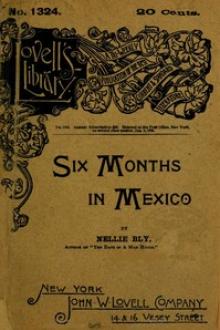Six Months in Mexico by Nellie Bly (best classic literature TXT) 📕

- Author: Nellie Bly
- Performer: -
Book online «Six Months in Mexico by Nellie Bly (best classic literature TXT) 📕». Author Nellie Bly
This is the only place in Mexico where we found a man who knew enough to have the flowers separated by a green lawn. It is the universal rule here to grow anything but grass, which is considered an unsightly weed. A Spanish gentleman once took me to see the grounds surrounding a Mexican mansion. The trees, flowers, and shrubs, as well as the statuary and fountains, could not be excelled, but the ground was bare as Mother Hubbard’s cupboard, and swept as clean as a dancing floor. “This place cost more than five million dollars, and thousands more yearly,” explained the gentleman. “You have nothing in the States to compare with it.”
Cordoba supports three public schools and male and female academies, one theater and about thirty churches. The finest church, located next to the plaza, cost thousands of dollars. It has a marble floor and twenty altars, dressed in the finest lace, with silver and gold ornaments. The frescoing displays exquisite workmanship. The images are wax-clad, and quaint.
The plantations surrounding Cordoba grow oranges, pine apples, coffee, bananas, tobacco, rice, cocoanuts and peanuts. Coffee was introduced into the West Indies in 1714, and here in 1800. It grows best in a temperate zone, and Vera Cruz raises more than any other state in Mexico. Most every variety requires protection from the sun, and will die if set out alone, so those having large groves plant coffee in them. Others make double use of their fertile land by planting groves of cocoa palms with the alternate rows of coffee trees. The leaf and bark of a coffee tree resemble that of a black cherry. The blossom is white and waxlike, with a faint perfume, and the berries grow on a branch like gooseberries. A tree will bear three years after planting the seed, and on one branch will have ripe and green coffee and blossoms all at the same time. When ripe it is gathered and laid on the ground to dry, being stirred every morning to dry it equally. This whips the hull off, and it is taken to the village, where it sells for four cents a pound. Each hull holds two grains. One tree will live and bear, with little or no cultivation, for eighty years. Bananas are four years old before they bear. The finer banana is never seen in the States, as it will not bear shipping. The kind shipped there the people here consider unfit to eat unless cooked, and they prepare some very dainty dishes from them. There are more than fifty different varieties, from three inches in length to three-quarters of a yard. The small ones are the best. The leaves are used by the merchants for wrapping-paper, and by the Indians for thousands of different things.
Tobacco now grows in about half the states of the republic, and thrives up to an elevation of six thousand feet. Formerly its cultivation was restricted to Orizaba and Cordoba, and a leaf of it found growing elsewhere, either accidentally or for private consumption, was, by law, promptly uprooted by officials appointed to watch for it. In 1820 two million pounds of it grew in this district, but now the output is greatly decreased, owing to the heavy taxes. Sugar cane grows in all but six states, up to an elevation of six thousand feet. It requires eighteen months for crops to mature, except in warmer soil, when it takes from eight to ten months.
One remarkable thing is, that the men who own the fine gardens surrounding the village do not live near them, as one would suppose, but inhabit stuffy little houses in the midst of the town. One bachelor has on his plantation plants from all parts of the world, over which he has traveled ten times. He cultivates all kinds of palms in existence, among which we noticed what is known as the “Traveler’s tree.” It is a strange looking thing, with long, flat, thick leaves growing up as though planted in the center and hanging loose at the ends. The flower is beautiful, with three long petals, the upper two white and the under one a sky blue. It is of a waxlike stiffness. Readers of books of travel will be familiar with the tree, it derives its name from the fact that it grows in the desert where no water is to be found. On thrusting a penknife into its body a clear stream of water, probably a pint and a half, will flow from one cut, and people traveling through the desert quench their thirst from this source, hence its name. The water is very cool and has a slight mineral taste, but is rather good and pleasing. It gives water freely all day, but, after the sun sets, is perfectly dry.
The bread and quinine trees are among his interesting collection. One odd plant attracted attention. It bore a round, green leaf, but wherever there is to be a blossom the four leaves turn a pretty red and form a handsome flower, each leaf forming a petal. The true blossom, which does not amount to much, being long and slim, like a honeysuckle, forms the stamens. It is of foreign importation, and grows in a climbing vine, whole arbors being covered with it. The grounds are surrounded by a hedge of cactus, which is strong and impassable. The Yucca palm and fruit cactus grew off in a corner by themselves. Several small streams run through this plantation, spanned by lovely rustic bridges. In the deep ravines are found ferns of every variety known, and on the trees a collection of orchids which, I believe, has no equal in any country. The happy owner, who is a bachelor worth about $20,000,000, lives in a little house in the center of this town, which has never been furnished until last winter, but in the courtyard he has plants from every country in the world, for which the shipment alone cost $40,000.
Down by Cordoba I found a tribe of Indians who are not known to many Mexicans excepting those in their vicinity; they are called the Amatecos, and their village, which lies three miles from Cordoba, is called Amatlan; their houses, although small, are finer and handsomer than any in the republic. Flowers, fruit, and vegetables are cultivated by them, and all the pineapples, for which Cordoba is famous, come from their plantations; they weave all their own clothing, and have their own priest, church, and school. Everything is a model of cleanliness, and throughout the entire village not one thing can be found out of place; the women are about the medium height, with slim but shapely bodies; their hands and feet are very small, and their faces of a beautiful Grecian shape; their eyes are magnificent, and their hair long and silky; they dress in full skirt, with an overdress made like that we see in pictures of Chinese women, or like vestments worn by priests of the Catholic Church. It is constructed of cotton in the style and pattern of lace. Around the neck and ends it is beautifully embroidered in colored silk, the dresses always being white. On the feet they wear woven slippers of a pink color, and on their heads a square pink cloth long enough in the back to cover the neck, like those worn by peasant girls in comic operas; the arms are bare, covered alone with bands and ornaments; the neck is encircled with beads of all descriptions, and is also hung with silver and gold ornaments; the earrings are very large hoops, like those introduced into the States last fall; they never carry a baby like other tribes, but all the children are left religiously at home.
The men are large and strongly built, not bad-featured, and wear a very white, low-necked blouse and pantaloons, which come down one-third the distance between waist and knee. They also wear many chains, ornaments, bracelets, and earrings. They are always spotlessly clean, and if they have a scratch on their body - of which they get many traveling the thorny roads - they do not go outside their village until entirely healed. They are industrious and rich, and never leave their homes but once a week, where they bring their marketing and sell to the Indians in Cordoba, as they are never venders themselves, selling always by the wholesale. Their language is different from all the others, but they also speak Spanish. The women are sweet and innocent. They look at one with a smile as frank as a good-humored baby’s, and are undoubtedly the handsomest and cleanest people in the republic. I would not have missed them for anything, and can now believe there are some Indiana like the writers of old painted them.
In the time of Maximilian a colony of Americans asked the emperor for land on which to settle. He kindly gave them their own choice, and they settled at Cordoba, where they had the advantage of the tropical clime and were secure from yellow fever. They were three hundred in number, and in a short time, with true American industry, they made business brisk. Three American hotels were established, and the plantations were the finest and most prosperous in the land. Maximilian looked on the little band with favor and gave them ample aid and protection. During the rebellion the liberty party made raids on their homes, destroyed their property, and not only made them prisoners and hurried them off to Yucatan - a place from which there is no escape - but murdered them whenever they wanted some new amusement. Maximilian was powerless to help those who had prospered under his care, and just when he was to be shot the last of the colony, who feared the liberty party, deserted their once happy homes and went to another country. Only one remained, Dr. A. A. Russell, who has been the solitary American here for twenty years. The hotels have disappeared, and the plantations, now possessed by Mexicans, bear no traces of their once tidy and prosperous appearance; this is the history of the first and last American colony ever formed in Mexico, given me by the last remaining colonist, who reminds one of the last chief, inconsolable and disconsolate, keeping vigil at the tombs of his people until death shall claim him too.
CHAPTER XXI.
A MEXICAN ARCADIA.
“IF you come over here you will get a better view,” spoke a gentleman as he came from the back end of the car hauling us from Cordoba to this place. We were nearly breaking our backs in a vain endeavor to look over a man and wife, surrounded by almost as many children as belonged to the old woman in the shoe, down the perpendicular side of the mountain into the deep ravine beneath. We took a survey of the speaker, of his light woolen suit with wide sombrero to match, his pleasant, handsome face, and mentally decided that he was not only worth looking at, but also worth talking to. By the time the train had passed the barranca we were in a deep conversation,





Comments (0)